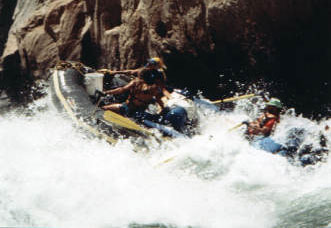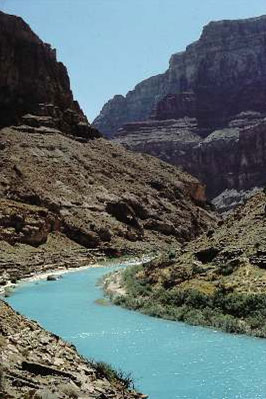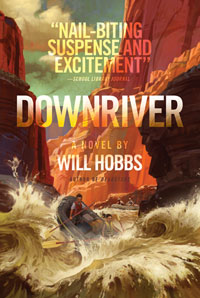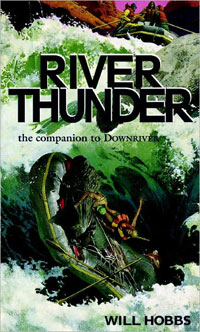 |
Yes. My wife, Jean, and I have been fortunate enough to take our own raft down through the Grand Canyon ten times. Each time we go, we travel with a small group of friends, usually four to eight people, although we've done a few trips with groups of fifteen, and one all by ourselves, just the two of us and our raft. These are trips we plan ourselves, taking along everything we'll need for up to 18 days. The Grand Canyon is wilderness —no picnic tables, no campgrounds, and definitely no fast-food stops! There are more hikes than you could do in a lifetime, and rock walls at the bottom that are close to two billion years old! It's a 225-mile trip with 160 rapids to run, like Granite Rapid, shown in the photo. That's me rowing my raft. Granite's a 9 on the Grand Canyon rating scale of 1-10. So, writing a whitewater novel for you must have been like Not exactly! I wanted to share my love of the Canyon with kids, but didn't know how at first. I had plenty of knowledge about the rapids, the conditions, the plants and animals, and so on, but that doesn't make a story. Downriver didn't come together for me right away. In the first draft, for example, the kids never ditched out on their adult leader. The first draft lacked tension, lacked drama, and wasn't about much except seeing the Grand Canyon. Starting with the second draft, I thought, What if these kids ditched out, called themselves “river pirates,” and tried it on their own? Now, that would make a story—doing something really rash, then living by the consequences. It would get so intense. Some of them would grow in that situation, others would not. . . . What else changed as you were writing Downriver? The narrator. I wrote three very different drafts, each told in the first person by a different kid. Jessie didn't appear until my third try. I had the other characters from the very beginning, but not Jessie. What happened to the other two narrators? Once they didn't make the “audition” for the storyteller, they disappeared. They didn't have another role. One was a girl, by the way, and the other was a boy. The voice of the storyteller is so important—it really needs to sound authentic. Until I landed on Jessie, I didn't have a narrator who would jump off the page and come to life. Why did you choose to write these two books from a girl's It was partly because it was the next challenge for me as a writer, to imagine the world from a girl's point of view, but mostly it was because I thought that outdoor adventure novels needed to catch up to real life. Outdoor adventure is every bit as appealing to girls as it is to boys. Just look around at who's out there skiing, mountain biking, kayaking, river rafting, climbing—girls are active in every kind of sport. On our own hikes and river trips we see at least as many girls as boys. Where did you get the ideas for your characters? Some I modeled loosely on former students of mine, others came from people who had been on river trips with us. When I'm starting to create a character, it helps me a lot to be able to picture a particular individual, to hear them talking, to visualize what they'd do in a situation. If I can begin with at least a few personality characteristics of an actual person, it immediately makes the character more real for me. Then I have something to build on. Often I'll combine personality characteristics I've observed in a number of different people, so the characters in the book end up being very different from the person I started with. What about Troy, the boy who had so much influence on all the other kids? I'd had some experience with a kid a lot like Troy, and wanted to dramatize just how much power an appealing but manipulative leader can have on a group. The other kids trust him in the beginning, and Jessie is quite taken with him. As the dangers of their situation become clearer to them, each of those seven kids who are on their own in the Grand Canyon will need to start thinking for themselves, figuring out who to listen to, who to trust. They need to come together as a group, in the interest of their own survival.
I'll bet all of the parts about the Grand Canyon itself are real. Exactly. If Jessie talks about the poison ivy at a certain location, it's really there. It was great fun for me to describe the amazing attractions down there, like the side stream called the Little Colorado, which Jessie names the River of Blue. (See photo.) I made the song of the canyon wren a sort of theme in the book and a strong touchpoint between Jessie and Star, who become very close. Friendship is a big part of this story. Did any of the things that happen to them down there happen to you? Once my brother-in-law brought a scorpion into camp in a blue plastic soap dish. You can see how I ran with that in the novel! The scene in which they're cooking breakfast at their tiny camp below the walls of the inner gorge, and a thunderstorm breaks and sends waterfalls and rocks into their camp, is practically a blow-by-blow account of something that happened to us once on the exact spot. We had to throw everything onto the rafts in about five minutes and get out on the river where we'd be safe from falling debris and cascading water. River Thunder, the sequel, is based even more closely on my own experiences. You ran the Colorado River at flood stage, like the kids did I sure did, and it was wild! The amazing part is that this all happened to us on our very first trip down the Grand Canyon! You can read all about my personal adventures in the Author's Note at the end of River Thunder. In River Thunder, Jessie ran Lava Falls at 70,000 cubic feet per second, which sounded enormous. Did you? That was the exact level we ran it at. I took a sequence of photographs of one of the women in our group rowing her small raft over the edge and through Lava Falls. She and her passengers were simply buried with whitewater, but they came through unscathed. I was really pleased to be able to have Jessie row the entire river in the second book. She took a few bumps, but she's hooked for life! Most of the same characters are in this story as were in the first book, and they all grow and change when faced with the incredible danger of the high water. Would you recommend that your readers run the Colorado through the Grand Canyon? I hope that every one of them will, at some point in their lives. It's the Great American Adventure! Every mile of the river is so stunningly beautiful, and there are all those little paradises waiting to be explored in the hidden side canyons, with waterfalls and plunge pools and maidenhair ferns. You can do it on your own if you have the experience and can get a permit, or you can pay to go with one of the professional river companies. More than twenty percent of the rowing guides today are women, by the way. In River Thunder, Jessie is invited to train with one of these rowing companies the following summer. My guess is that she'll be spending a lot more time on the river. You could talk about the Grand Canyon all day. Don't get me started! Note: For more info on the writing of River Thunder, see the Author's Note at the end of the book. |
|



